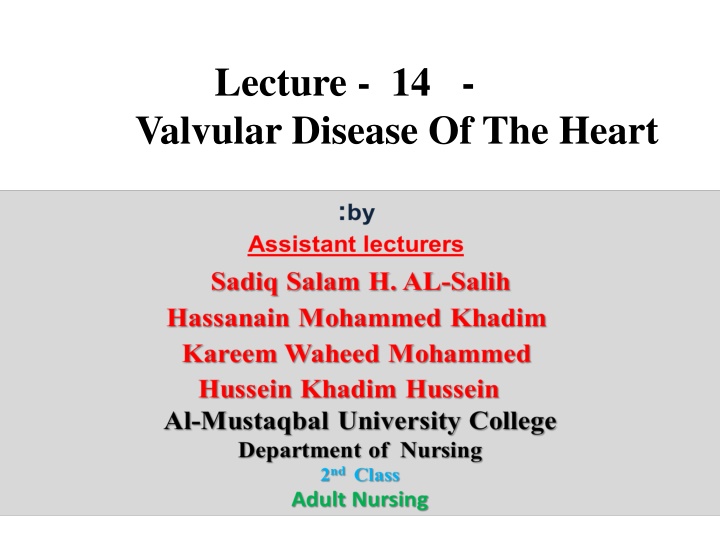
Valvular Heart Disease: Causes, Symptoms, and Diagnosis
Valvular heart disease affects the function of heart valves, leading to conditions like mitral stenosis and regurgitation. Learn about the causes, clinical manifestations, and diagnostic methods of these disorders. Early detection and management are crucial for better outcomes.
Download Presentation

Please find below an Image/Link to download the presentation.
The content on the website is provided AS IS for your information and personal use only. It may not be sold, licensed, or shared on other websites without obtaining consent from the author. If you encounter any issues during the download, it is possible that the publisher has removed the file from their server.
You are allowed to download the files provided on this website for personal or commercial use, subject to the condition that they are used lawfully. All files are the property of their respective owners.
The content on the website is provided AS IS for your information and personal use only. It may not be sold, licensed, or shared on other websites without obtaining consent from the author.
E N D
Presentation Transcript
Lecture - 14 - Valvular Disease Of The Heart
Definition: The function of normal heart valves is to maintain the forward flow of blood from the atria to the ventricles and from the ventricles to the great vessels. Valvular damage may interfere with valvular function by stenosis or by impaired closure that allows backward leakage of blood (valvular insufficiency, regurgitation, or incompetence).
Valvular Disorders Mitral stenosis Mitral regurgitation Mitral valve prolapse Aortic stenosis Aortic regurgitation
Mitral Stenosis Most common cause: rheumatic fever Results from rheumatic carditis Causing valve thickening by fibrosis and calcification Non-rheumatic causes Atrial tumor Calcium accumulation
Diagnostics Echocardiogram Chest X ray EKG Cardiac catheterization
Clinical Manifestations Mild stenosis Asymptomatic Beginning Dyspnea on exertion (DOE) Orthopnea Paroxysmal nocturnal dyspnea (PND) Dry cough Later Hemoptysis(Cough with Blood) Pulmonary edema Right-sided heart failure Hepatomegaly (Enlargement of the liver) Neck vein distention (JVD) Pitting edema Apical diastolic murmur
Mitral Regurgitation Mitral Regurgitation (Insufficiency) Fibrotic and calcific changes prevent the mitral valve from closing completely during systole. End result left atrial and ventricular dilation and hypertrophy. Causes Rheumatic heart disease Degenerative calcification Left ventricular hypertrophy MI Congenital defects
Clinical Manifestations Progresses slowly Asymptomatic for decades Chief complaints Fatigue Chronic weakness DOE Orthopnea Normal blood pressure Atrial fibrillation (75% of all clients). Changes in respiratory patterns High pitched systolic murmur at apex Third heart sound (S3 or S4)
Surgical management Valve replacements Prosthetic Biologic Surgical repairs Balloon valvuloplasty cath lab Reconstructive or Valvuloplasty : a. Open commissurotomy b. Annuloplasty repairs
Pre-Operative Care Similar to CABG surgery Pain Incisional care Prevent pulmonary complications - STOP oral anticoagulants 72 hours before procedure Post-Operative Care Respiratory care Monitor for hemorrhage Cardiac output reduction Discharge teaching
Complications Fluid & Electrolyte imbalances Hypotension Bleeding Cardiac tamponade Altered cerebral perfusion Hypothermia Hypertension Infection
Client Education Disease process Medications Anticoagulants Prophylactic antibiotics Rest and activity plan


















